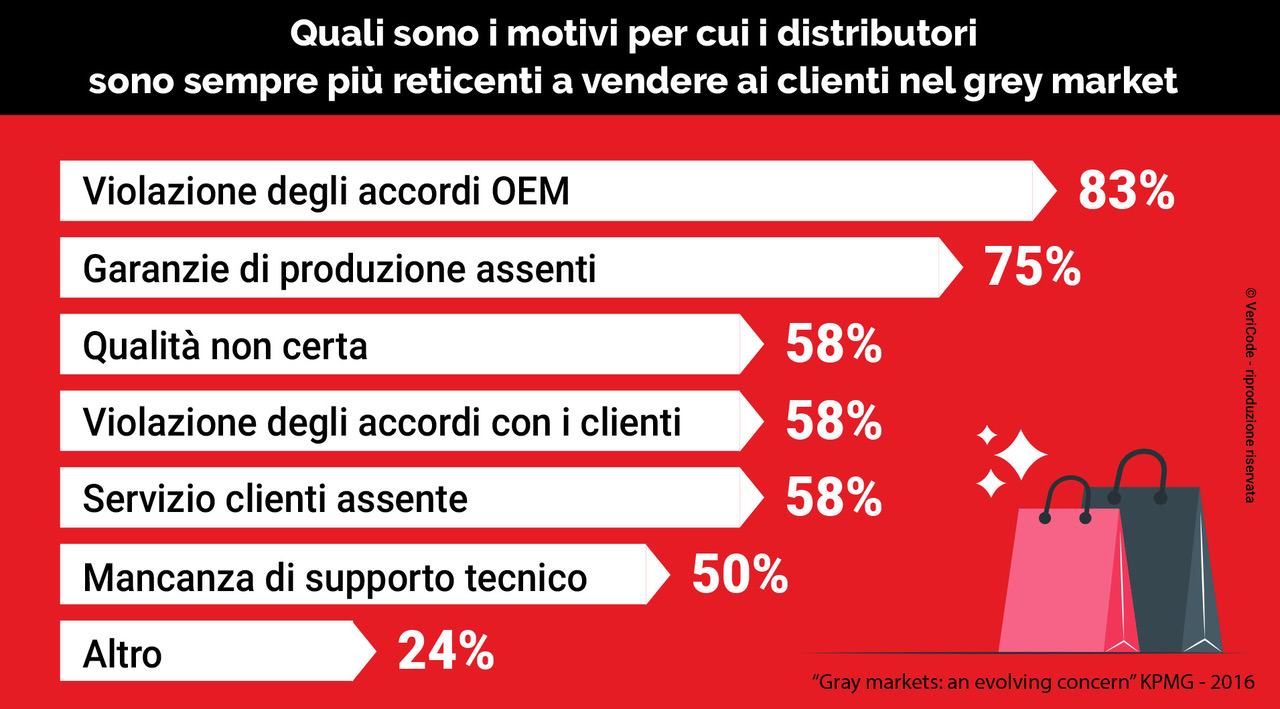
Gray market: what it is, how it works and how to counteract it
The Gray Market, in the face of the sale of authentic products, is a phenomenon that damages both brands and consumers. It is a business model that is not illegal: with respect to commercial regulations, it just exploits the legal loopholes that exist in the global market..
The rising wave of e-ecommerce unleashed by the pandemic has led to a surge in daily online transactions on international market scales, which has made it increasingly difficult to identify products sold especially in the parallel luxury market.

Gray market: what it is and how it works
Unlike the black market linked to counterfeiting , the gray market sells authentic goods at a significant discount (generally between 15% and 35%). This often happens without any contact with the original brands, using alternative channels that the brands have not authorized or have not foreseen. From a legal point of view, the procedure is correct because it is linked to a traditional regulated invoicing process. The gray market problem is linked to the inability of fashion and luxury operators to control their production volumes, overseeing the gray areas linked to uncontrolled sales and prices.
Examples of products sold on the parallel market
In the gray market, the original product is handled in an opaque way. Metaphorically speaking (but not so metaphorically), products can exit the back door of a factory or a truck at any stage of production, from the brand factory but also from the logistics operator, the phasonist or the official distributor. In other cases, it happens that the goods (watches, jewelry, clothing and accessories but also electronic devices) end up being marketed on the parallel market due to an excessive production of stocks. This can happen when the size of a nation's market has been incorrectly assessed by the official distributor, who finds himself having to resolve the management of surpluses. In these situations, a parallel trader can make a substantial profit by selling the excess stock to buyers in another country where there is demand. A series of authentic products are thus sold to end consumers at a much higher and attractive discount than the price agreed by the brand with its channel partners.
What products end up in the gray market
In recent years this attitude has changed profoundly. With e-commerce becoming more and more prevalent and companies like Baltini in Italy, Italist in the United States and the Australian Cettire emerging online, gray sales are ending up in millions of digital shopping carts. Cettire, which acts as an intermediary between boutiques and customers, is an emblematic case of how a company operates in the gray market, offering discounts of up to 30%. The e-commerce platform sells around 160,000 products from over 1,300 high-end and ultra-high-end brands (including Prada, Gucci, Chanel and Saint Laurent) through a process known as dropshipping. Dropshippers are online sellers who do not keep any product in stock: when an item is purchased, they buy it from abroad and ship it to the customer. Cettire takes a commission on sales, which primarily concern products made and priced in Europe to customers in the United States and Asia.
The gray market in the world: examples
- JAPAN - In Japan the gray market is very transparent: there are many physical boutiques that sell products from the gray market. This is because there is a law that prohibits a company from rejecting goods based solely on the fact that they are the gray market. As a result, Japan often ends up being a key market for gray market players. This creates a worldwide imbalance of products, making Japan a key destination for tourists looking for a fantasy deal.
- RUSSIA - After the invasion of Ukraine, the Russian government has given the green light to parallel imports in the wake of the interruption of operations in Russia by a wide range of Western brands. Russian Prime Minister Mikhail Mishustin has said retailers are free to import and sell branded products without the explicit permission of proprietary brands, thus opening the door to a free flow of gray market products in Russia, sold without consent of the trademark owner.
- CHINA - China's luxury gray market business is the consequence of the central government's decisions to impose abnormal import duties and tariffs to curb the consumption of non-Chinese products. The result of this fiscal policy was the rush of the Chinese to make their purchases abroad. The phenomenon has therefore assumed enormous proportions and develops in the most various possible forms: ranging from real smuggling, to the parallel online market, to the travel retail of Chinese tourists around the world who buy on behalf of foreign buyers and then resell the products in China, Russia and South Korea. Added to this are the so-called daigous or Chinese (but also South Korean) personal shoppers, who buy luxury items not available or highly taxed abroad on behalf of resident customers and who are proliferating on Instagram. According to a study conducted by Bain in 2015, the gray market resulting from the sales of daigou was worth € 8 to 11 billion, which represents 15% of total luxury purchases by Chinese customers on each network. A business so large that it has become much more important for many import brands than the sales made through the official sales network.
The negative impact of the gray market on consumers
In search of the cheapest price, many consumers are looking for alternative ways to buy authentic products at lower prices. The sale of the product to the end customer does not take place through official resellers, but through shops or distributors who, having not been officially selected and qualified, are unlikely to be able to meet the quality and service requirements that original manufacturers require from their own certified sales channels. This means that, in case of problems with the product (breakdown, defect, need for spare parts or assistance), the customers will most likely not only not get the service he expects, but they will not even be able to contact the brand which, not recognizing the source of the sale, is not required to offer any assistance. Less than a third of brands, in fact, offer guarantees also for products sold on the gray market.
Gray market: what is changing
As analysts note, many luxury brands have up to now turned a blind eye or even allowed themselves sales in the gray market, because the operation has allowed them to significantly reduce waste and make margins. All this by enriching the numbers shared with the sales partners, keeping brand awareness high. In recent years, however, analysts point out that in addition to producers, many distributors have also begun to change attitudes towards the gray market for different reasons.

Incidentally, the researchers pointed out that distributors would prefer not to participate in the gray market but are obliged to do so in order to remain competitive with all those companies willing to violate contracts with OEMs and the terms of the incentive programs signed.
How OEMs can be protected from the gray market
In the fight against the gray market, OEMs (Original Equipment Manufacturers) still bear most of the costs. The first line of defense includes contractual provisions against the distribution of products through unauthorized channels. The second line of defense consists in activating inspectors who monitor the shops, possibly filing a legal action, which often results towards unknown persons. In fact, even this system turns out to be inefficient. In summary, the measures taken are proving largely insufficient to dissuade channel partners from operating in the gray market.
AutoID essential for tracking and tracing
To reduce this risk, companies must have a strategic protection solution. Almost 7 out of 10 fashion and luxury manufacturers have relied on AutoID to introduce more or less advanced product tracking and tracing technologies:
- Serialization
- Item-level RFID chip
- customized inks and dyes
- holograms
- sensorized packaging
- latest generation smart code
Warning: not all technologies are effective
These solutions help brands gain greater visibility into product handling throughout the supply chain: from manufacturer to dealer, from conveyor to warehouse, from distributor to final retailer. Some technologies are very valid in terms of logistics but are not sufficient in the case of the gray market. In the case of serialization, for example, vendors can remove these numbers to prevent product traceability and disruption of supply of the item, which means the item cannot be brought to a brand boutique for repairs. Removal of serial numbers goes hand in hand with lack of warranty - a gray market buyer will not have the benefit of repair services, despite purchasing a genuine product. Although he may have received a short-term guarantee from a gray market vendor, it may not provide the protection they imagine. In case of problems, when a consumer takes the product in question to an authorized boutique, he will not benefit from any manufacturer's guarantee.
Countering the gray market from producer to consumer
The most efficient solution to combat the phenomenon of the gray market is to apply a traceability system based on RFID (Radio Frequency Identification) tags to the entire supply chain. By defining a unique identification code for each individual garment and equipping himself with the necessary control software, the brand owner acquires the ability to verify compliance with the agreements made with partners throughout the supply chain at any time. The problem with RFID tags is that end consumers cannot independently log in to see if the product they are buying belongs to the white market. In this sense, VeriCode is a unique solution of its kind, tracing, certifying and enhancing the information relating to any type of product, in an effective and functional way throughout the supply chain, including end customers.
In fact, as the final output of the traceability process, Vericode generates a QrCode that customers can easily read using their smartphones or tablets. Scanning the code allows them to access information in a unique and certified way that indisputably guarantees not only that the product they are about to buy is authentic, but also that it has all the support warrantees associated.
Find out what Vericode can do for you!
Vericode: easy to implement, intuitive to read
The system uses an artificial intelligence system based on neural networks to analyze suspicious events along the supply chain. Vericode guarantees great modularity and flexibility, adapting to the type of product, business and final target. Each brand can follow every single product traced along the entire supply chain, thanks to analysis and business intelligence tools capable of offering, within an easy-to-use dashboard, reports and alerts tailored to the specific needs of the business.
- Log in to post comments